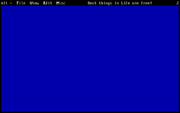Conway's Game of Life
Press Keyboard right side: Alt+Enter keys to switch to full screen game play, and Alt+Enter keys to return.
How to play Conway's Game of Life
Each game uses different controls, most DOS games use the keyboard arrows. Some will use the mouse.
Conway's Game of Life Description
Some programs conventionally considered games are simulators that have been described as "software toys", such as Little Computer People or the iterations of Will Wright's Sim franchise, concerning themselves with the life cycles of simulated entities; in The Sims, it's the lives and deaths of people being simulated, while in Conway's Game of Life, it's the lives and deaths of single-celled entities (or "cellular automata"). These entities live on cells of a flat, 2D binary Cartesian grid and their life and reproduction is dictated according to a few demanding conditions. From step to step, their amount of adjacent neighbors (above, below, on the sides and diagonally) are measured: fewer than two or more than three, and the inhabitant of the cell will die; exactly two or three and they will remain stable; finally, any uninhabited square with three neighbors will spawn forth a new entity. The player is a Newtonian clock maker god, arranging starting conditions of cell locations on the grid and then setting the system into motion to continue, untouched and unabated, as the game plays itself, evolving, and generations of cells tick along and produce kaleidoscopic patterns, flickering oscillators and stubborn, stable little clumps and lumps (or "still lifes"). The game was originally worked out slowly, by hand, on grid paper, blackboard or using tiles on a Go board, after being popularized in Martin Gardner's "Mathematical Games" column in Scientific American in October 1970, but increasing availability of computers have enormously expanded the options available (and enormously reduced the time and labor needed) to cell pattern researchers.

















